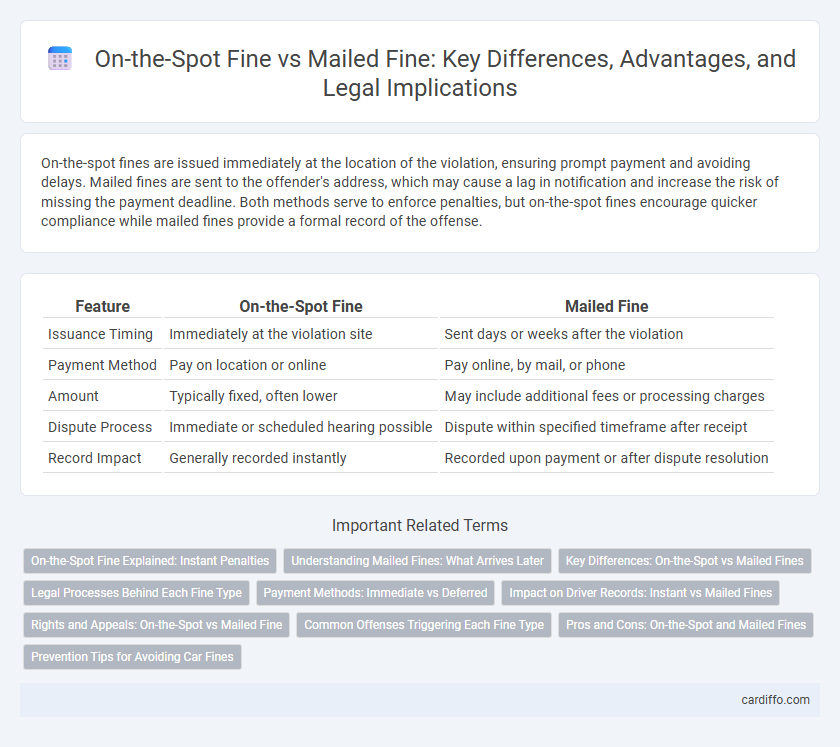On-the-spot fines are issued immediately at the location of the violation, ensuring prompt payment and avoiding delays. Mailed fines are sent to the offender's address, which may cause a lag in notification and increase the risk of missing the payment deadline. Both methods serve to enforce penalties, but on-the-spot fines encourage quicker compliance while mailed fines provide a formal record of the offense.
Table of Comparison
| Feature | On-the-Spot Fine | Mailed Fine |
|---|---|---|
| Issuance Timing | Immediately at the violation site | Sent days or weeks after the violation |
| Payment Method | Pay on location or online | Pay online, by mail, or phone |
| Amount | Typically fixed, often lower | May include additional fees or processing charges |
| Dispute Process | Immediate or scheduled hearing possible | Dispute within specified timeframe after receipt |
| Record Impact | Generally recorded instantly | Recorded upon payment or after dispute resolution |
On-the-Spot Fine Explained: Instant Penalties
On-the-spot fines provide immediate penalties issued by authorities at the location of an offense, ensuring swift enforcement of regulations. These instant fines enhance compliance by eliminating delays associated with mailed fines, which require processing and postal delivery. Authorities utilize on-the-spot fines to effectively address violations such as traffic infractions, public disorder, and minor legal offenses, streamlining the penalty process.
Understanding Mailed Fines: What Arrives Later
Mailed fines typically arrive days or weeks after the violation, containing detailed information about the offense, payment methods, and deadlines. Unlike on-the-spot fines issued immediately, mailed fines require recipients to carefully review the documentation to avoid late penalties or additional fees. Understanding the mailing process and response requirements ensures timely resolution and helps prevent escalation or legal consequences.
Key Differences: On-the-Spot vs Mailed Fines
On-the-spot fines are issued immediately at the location of the violation, requiring prompt payment or contesting, while mailed fines arrive later via postal service, providing additional time before payment deadlines. On-the-spot fines often include immediate interaction with law enforcement, enhancing compliance, whereas mailed fines rely on documented notices and follow-up reminders. The immediacy of on-the-spot fines generally leads to quicker resolution, contrasted with the longer processing periods typical of mailed fines.
Legal Processes Behind Each Fine Type
On-the-spot fines require immediate payment or contestation, streamlining the legal process by resolving minor infractions quickly without court involvement. Mailed fines initiate a formal notice procedure, allowing recipients to review the offense and deadlines, often leading to court hearings if contested. Legal frameworks for both fine types emphasize due process, with on-the-spot fines prioritizing swift enforcement and mailed fines ensuring documented evidence and claimant rights.
Payment Methods: Immediate vs Deferred
On-the-spot fines require immediate payment, facilitating quick resolution and reducing administrative overhead. Mailed fines offer deferred payment options, providing recipients additional time to settle the amount via online portals or mail-in checks. Immediate payment methods minimize the risk of non-payment, while deferred options enhance accessibility and convenience for the fined parties.
Impact on Driver Records: Instant vs Mailed Fines
On-the-spot fines are immediately recorded in driver records, potentially affecting insurance rates and license status without delay. Mailed fines may have a processing lag, allowing a short window before impacting the driver's record, but failure to pay on time can lead to escalated penalties. Immediate documentation with on-the-spot fines increases accountability and swift enforcement in traffic violations.
Rights and Appeals: On-the-Spot vs Mailed Fine
On-the-spot fines typically require immediate payment or acceptance of the penalty, limiting the opportunity to contest before the fine is finalized. Mailed fines often provide a clear process for submitting appeals or disputes within a specified timeframe, protecting the individual's rights to challenge the charge. Understanding the differences in appeal procedures ensures proper exercise of rights when dealing with fines issued on-the-spot versus those received by mail.
Common Offenses Triggering Each Fine Type
Common offenses triggering on-the-spot fines typically include minor traffic violations such as illegal parking, speeding in low-risk zones, and failure to wear a seatbelt, allowing authorities to promptly address infractions. Mailed fines often relate to offenses detected through automated systems like red-light camera violations, expired registrations, or toll evasion, where identifying the offender requires administrative processing. Understanding these distinctions helps drivers anticipate the enforcement method depending on the nature and detection of their traffic violation.
Pros and Cons: On-the-Spot and Mailed Fines
On-the-spot fines provide immediate resolution, enabling quick compliance and reducing enforcement costs but may pressure individuals to pay without full understanding of their rights. Mailed fines allow more time for appeal and administrative processing, offering fairness but potentially leading to delayed payments and increased administrative burden. Both methods balance efficiency and due process, with on-the-spot fines favoring speed and mailed fines prioritizing procedural fairness.
Prevention Tips for Avoiding Car Fines
Car owners can prevent on-the-spot and mailed fines by adhering strictly to parking regulations, such as avoiding parking in no-parking zones and respecting time limits. Utilizing parking apps to monitor and extend paid parking sessions reduces the risk of expired meters. Regularly inspecting vehicles for valid registration and license plates also helps avoid mailed fines resulting from administrative violations.
On-the-spot fine vs mailed fine Infographic

 cardiffo.com
cardiffo.com